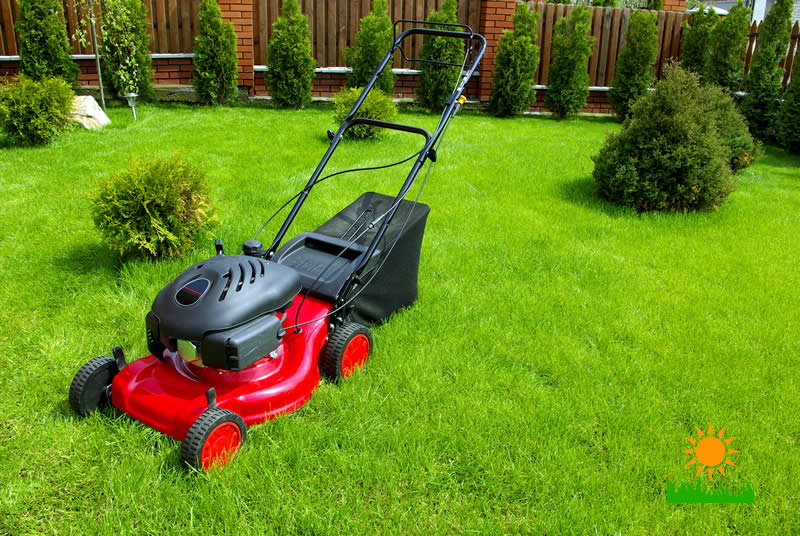There’s nothing like the look and scent of a freshly cut lawn; which is why maintaining your gas mower is essential. Truth is, your lawn mower takes a lot of abuse and like any other machine it can break down. Good thing is, most issues can be avoided with proper maintenance and most problems can be easily spotted and fixed.

Our troubleshooting guide to maintaining and repairing your lawn mower will help you care for it the right way, so you can spend less time mowing and more time relaxing.
How to Maintain and Repair Your Lawn Mower
To make our guide easy to follow, we will tackle maintenance and repairs for each of the main components of your mower: spark plugs, air filtration system, fuel system
Spark Plugs
Spark plugs are what “spark” your mower and get it to ignite and fire up your machine; so, if you’re spark plug is dirty or disconnected, you won’t have any power. Before you can address any issues though, you need to remove the plug in self-propelled mower.
The spark plug can be found on the side of your machine’s engine and is sideways; there is a rubber cap that protects it, so you may not see it right away. You can remove the cap and the spark plug wire it’s attached to by pulling straight out.
Then, use a spark plug wrench or deep socket wrench to remove the actual spark plug by slowly turning counter-clockwise.
Common Spark Plug Problems
- A disconnected Wire: Sometimes you can see the wire hanging and other times the cap makes it appear that it’s still connected when it’s not; check and firmly reattach it if it’s not properly connected.
- Loose Plugs: After repeated uses a spark plug may detach itself from the engine. This is another simple fix, as all you need to do is gently turn clockwise.
- Dirty: Your mower is constantly in contact with debris, grass dirt, and oil, which can cause the plug to become soiled and dull; which means it won’t spark.
Dirt, oil, grass, and other forms of gunk may have infiltrated the spark plug, compromising its ability to spark. Sometimes a simple cleaning will fix it. Clean the area around the cap before you remove it and the plug so nothing else gets in; then wipe the plug with a spark plug cleaner and wire brush. - Defective: If you can’t remove build-up or the plug is cracked or otherwise compromised it may be time to get a new spark plug.
Air Filter
The thing to understand about air filters is that as they clog they slowly damage the engine because there is not sufficient cooling air hitting it. And the problem can take time to see. To avoid this, here are some signs to look for that your filter might be dirty:
- Loss of Power: Your mower loses power and stalls especially in areas with thick or wet grass.
- Excessive Fuel Consumption: If your mower suddenly needs more gas to get the same size lawn mowed this is an indication that it’s guzzling gas and a dirty filter may be to blame.
- Engine Running Rough: A choking, sputtering, coughing engine indicates it’s not getting enough air.
Cleaning the Filter
To clean the filter find it on the side of your engine; it is usually covered with a metal or plastic cover. Remove the filter and make sure there are no cracks or tears. Foam filters can be cleaned using soap and water and then air-dried. Paper filters can be cleaned with a small vacuum or by tapping debris to loosen it.
Replacing the Filter
Most times you are better off replacing the filter. Follow your unit’s instructions to ensure it is done properly.
Fuel System
Fuel needs to flow through your machine for it to work right. Before determining if there is a problem you must be smart. Take out the spark plug and wear gloves. Then, as long as the engine is cool you can drain it and tackle issues with any of the fuel system components.
Fuel Cap
Fuel caps have a small hole at the top that can be clogged, blocking flow. If it is you can remove the cap and use an air compressor to blast it clean.
Fuel Line and Filter: How to Repair & Maintain it
Start by checking to see if there is a fuel valve and turn it off if there is. Then, remove the engine cover and take out the fuel tank. Use pliers to disconnect the fuel line, pinching the clamps located at either end of the line.
If the line is cracked you can replace it; if not you can clean it out with an air compressor. Finally, if your machine has a fuel filter check to see if it needs to be replaced.
And there you have it, our guide to troubleshooting and maintaining your push lawn mower. As you can see with time and care it is pretty easy to keep your mower purring and your lawn lush and green.
